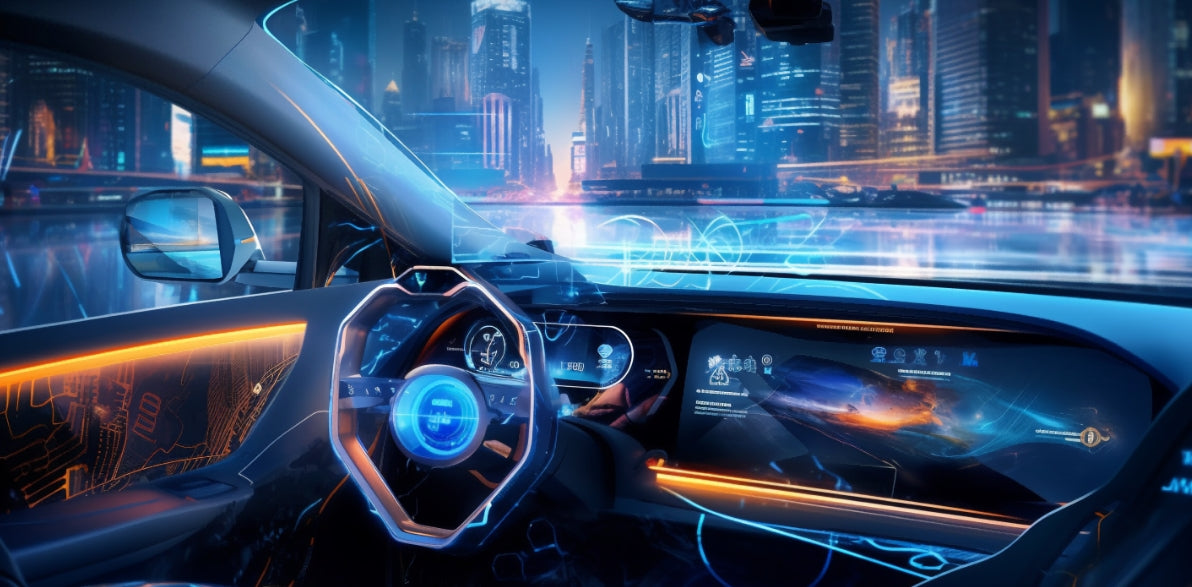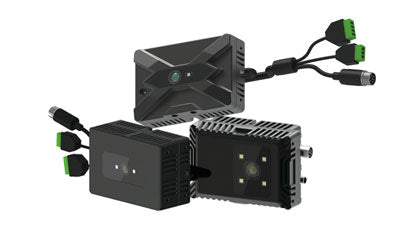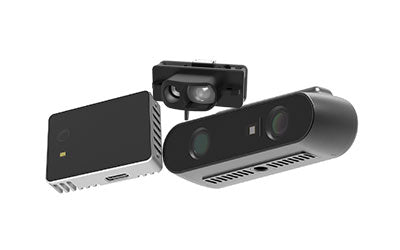TOF in Edge Fusion Perception for Autonomous Driving

With the rapid development of autonomous driving technology, achieving comprehensive perception, precise decision-making, and safe control has become a key focus in the industry. At the perception layer, LiDAR (Light Detection and Ranging), cameras, and TOF (Time-of-Flight) sensors form the core multi-sensor fusion perception framework. Among them, TOF technology, with its high accuracy, low latency, and strong anti-interference capabilities, is accelerating its deployment in near-field perception and edge intelligence applications for autonomous driving.
Multi-Sensor Fusion: The Collaborative Framework of TOF + LiDAR + Camera
Current mainstream autonomous driving perception systems typically adopt a multi-sensor fusion architecture combining LiDAR + Camera + Millimeter-wave Radar to achieve comprehensive and accurate environmental perception. Recently, TOF (Time-of-Flight) sensors, as an emerging 3D imaging technology, have gradually entered the autonomous driving perception stack, showing significant advantages especially in short-range perception and dynamic scene modeling.
Roles and Advantages of Each Sensor
-
LiDAR: Provides excellent spatial perception ability by generating high-density, high-precision point clouds that reconstruct the 3D structure of the surrounding environment. It is particularly suited for mid-to-long range object detection and road topology mapping, making it indispensable for high-level autonomous perception.
-
Camera: Uses image recognition algorithms to identify object categories, lane markings, traffic signs, and traffic light status, delivering rich semantic information. Cameras are cost-effective but their stability is impacted by extreme lighting conditions such as strong sunlight or darkness.
-
TOF Sensor (3D TOF Camera): Based on the time-of-flight principle, it emits modulated light and measures the time it takes for the light to reflect back to calculate distance. It features strong real-time performance, high precision, and fast response speed. Compared to LiDAR and cameras, TOF excels in short-range 3D perception, such as recognizing nearby obstacles, pedestrians, and vehicle contours, as well as complementing visual blind spots to enhance near-field environment modeling.
Advantages of TOF + RGBD Fusion Solutions
In advanced RGBD vision systems (such as combined TOF + RGB camera modules), joint processing of depth maps and color images enables:
-
More accurate object segmentation and recognition, improving the stability of dynamic object tracking (e.g., pedestrians, cyclists);
-
More natural human body contour modeling, suitable for passenger detection, fatigue monitoring, and gesture control in intelligent in-cabin interaction scenarios;
-
Stronger robustness and fault tolerance, maintaining high perception quality under backlight, nighttime, or degraded visual conditions;
-
Centimeter-level obstacle avoidance in close-range scenarios like garage parking and low-speed driving, significantly reducing collision risks.
Future Outlook: A Key Component of Intelligent Perception
With continuous improvements in automotive AI chip computing power, multi-sensor fusion perception architectures will become increasingly intelligent. Due to its compact size, low power consumption, and rapid response, TOF sensors are poised to become a critical part of future integrated in-cabin and external vehicle perception systems, showing great potential in L4/L5 autonomous driving, smart cockpits, and human-vehicle interaction applications.
What is a 3D ToF Camera?
A 3D ToF (Time of Flight) camera captures three-dimensional information by measuring the time taken for emitted light to travel to an object and reflect back to the sensor. The core principle involves emitting infrared or laser pulses; after reflection from the object surface, the sensor calculates the distance based on the flight time of the light, generating depth maps and 3D images.
Key Features:
-
Real-time 3D data acquisition: Unlike traditional cameras capturing only 2D images, ToF cameras provide per-pixel depth information;
-
High precision and fast response: Suitable for depth perception in dynamic scenes;
-
Strong immunity to ambient light interference: Can operate in low or no-light environments;
-
Wide applications: Used in facial recognition, gesture recognition, autonomous driving, robot navigation, AR/VR, and medical devices.
3D ToF cameras represent an advanced sensor technology leveraging the time-of-flight principle to obtain 3D structural information through distance measurement.
TOF’s Outstanding Advantages in Near-Range, Low-Speed Scenarios
In autonomous driving’s low-speed scenarios such as congested urban roads, automated parking, lane changing, and intersection turning, the demand for real-time and precise environmental perception is high. Compared to traditional cameras and ultrasonic sensors, TOF technology, with its high-resolution depth sensing and strong anti-interference capability, exhibits superior adaptability and practical value in these complex near-field situations.
-
Automated Parking: Traditional parking assist systems rely on ultrasonic sensors, which are prone to false positives or missed detections in the presence of metal reflections, non-perpendicular obstacles, or confined spaces. TOF cameras provide real-time, high-precision 3D distance measurements to obstacles, enhancing the accuracy and safety of automated parking path planning, even in dim or complex lighting environments.
-
Lane Change Assistance: In narrow urban roads or multi-lane merge zones, TOF sensors installed on vehicle sides provide real-time 3D monitoring of blind spots. Their high refresh rate and low latency ensure timely detection of potential risks such as adjacent vehicles or pedestrians, effectively assisting drivers in performing safe lane changes.
-
In-Cabin Gesture Recognition and Human-Machine Interaction (HMI): In smart cockpits, 3D TOF cameras enable non-contact interaction by recognizing passenger hand gestures. Users can perform swipe, rotate, or tap gestures mid-air to adjust air conditioning, volume, music tracks, or navigation zoom levels, enhancing driving comfort and technological experience. This is especially suitable for low-distraction interaction scenarios during driving.
The realization of these applications depends on TOF cameras’ low latency response and strong structured light illumination anti-interference capabilities. Unlike traditional visible-light cameras and ultrasonic modules sensitive to environmental interference, TOF systems do not rely on ambient light and maintain stable depth data in day, night, and rapidly changing lighting conditions. Their compact size, low power consumption, and high efficiency make TOF increasingly the preferred choice for next-generation intelligent driver assistance and in-cabin perception systems.
Advantages of TOF Over Ultrasonic Sensors in Accuracy and Response Speed
Traditional automotive ultrasonic sensors, while cost-effective, have obvious drawbacks:
| Item | Ultrasonic Sensor | TOF Sensor |
|---|---|---|
| Distance Accuracy | Lower, typically centimeter-level | Millimeter-level precise ranging |
| Response Speed | High latency, low refresh rate | High refresh rate, strong real-time performance |
| Environmental Adaptability | Easily disturbed by rain and wind noise | Strong anti-interference, effective in strong and low light |
| Imaging Capability | No imaging, only obstacle detection | Supports 3D modeling and depth image fusion |
Therefore, an increasing number of next-generation 3D perception systems are replacing some ultrasonic sensors with TOF, achieving 'hardware-software co-evolution.'
Typical TOF Applications: Automatic Parking, Blind Spot Detection, In-Cabin Gesture Interaction
With continuous advances in automotive intelligence, TOF (Time of Flight) technology has been deployed and matured in many mass-produced vehicles. It excels in perception accuracy, response speed, and resistance to light interference. TOF enhances vehicles’ 3D environment sensing and provides reliable data support for various intelligent functions, particularly in the following core scenarios:
-
Automatic Parking Assistance (APA): TOF depth cameras work synergistically with visual SLAM and surround-view cameras to achieve high-precision mapping and localization of static and dynamic obstacles around the vehicle, enabling centimeter-level parking accuracy. In narrow spaces or nighttime conditions, where traditional sensors struggle, TOF can still reliably output high-quality 3D depth data, improving parking success rates and safety.
-
Blind Spot Detection (BSD): TOF sensors placed on vehicle sides conduct high-frequency depth scanning to monitor if nearby vehicles or pedestrians enter blind spots. Once a potential collision risk is detected, active safety measures such as sound alarms, steering wheel vibration, or automatic braking are triggered to assist the driver in avoidance. Compared with traditional millimeter-wave radar, TOF provides more intuitive 3D contour information with faster response.
-
Gesture-Controlled Human-Machine Interface (HMI): Inside the smart cockpit, TOF enables precise gesture recognition without requiring the user to wear any device. Users can control multimedia systems, air conditioning, sunroofs, etc., with natural hand gestures—for example, waving to change music, making pinch gestures to zoom the navigation map—enhancing interaction intuitiveness and immersion, setting a new benchmark for “contactless interaction.”
-
Driver Monitoring System (DMS): Leveraging TOF’s facial depth recognition, the system tracks the driver’s head pose, eye closure, gaze direction, and other behavior traits in real time, assessing fatigue, distraction, or drowsiness risk and issuing timely warnings. TOF maintains stable imaging under low light or backlight conditions, far outperforming traditional 2D cameras in recognition accuracy.
These TOF-driven intelligent systems rely on highly integrated 3D vision systems, RGB-D perception technology combining visible light and depth information, and high-performance 3D sensing hardware modules. Coupled with edge computing platforms and AI models, vehicles can locally perform complex data processing and real-time inference, boosting system responsiveness and protecting data privacy, thereby advancing toward higher levels of automation and intelligence.
TOF is no longer just a cutting-edge technology but the perception core for intelligent driving and smart cockpits, providing solid support to enhance driving safety and comfort.
Synergy with V2X Communication: Building a Full-Stack Vehicle Perception System
With rapid advances in intelligent transportation and autonomous driving, single-sensor perception can no longer meet the safety and efficiency demands of complex environments. As a high-precision short-range 3D perception device, TOF sensors, deeply integrated with V2X (Vehicle-to-Everything) communication technology, are leading vehicle perception systems to higher dimensions and wider coverage, promoting smart connected vehicles toward full-stack perception and collaborative decision-making.
-
Real-time Sharing of Near-Field 3D Information: Vehicles equipped with TOF sensors can upload precise 3D depth data to vehicle-road collaboration platforms (C-V2X/DSRC) in real time via V2X protocols, enabling rapid information exchange among vehicles and roadside infrastructure. This data sharing significantly improves the completeness and timeliness of environmental perception, helping anticipate and avoid potential risks.
-
Roadside Unit (RSU) “Perception Forwarding”: Roadside TOF sensors perform high-frequency 3D scans of key areas and synchronize perception data with passing vehicles via V2X. Compared to relying solely on onboard sensors with blind spots, this “perception forwarding” strategy effectively extends the vehicle’s perception radius, allowing early warning of obstacles, pedestrians, or unusual traffic conditions ahead, greatly enhancing safety.
-
Multimodal Autonomous Localization Fusion: TOF data, combined with Visual SLAM and AGV laser navigation systems, forms a multimodal localization framework that fuses vision, laser, and depth information. This complementary approach improves mapping accuracy and robustness, especially in complex urban environments and GPS-denied areas.
-
Facilitating L4-Level Autonomous Driving Deployment: The combined perception capabilities of TOF and V2X significantly enhance environmental understanding and dynamic responsiveness in urban districts, ports, and closed campuses. High-precision near-field sensing paired with vehicle-road collaborative data sharing effectively supports the stringent safety and efficiency requirements of L4 autonomous driving, accelerating commercialization of advanced autonomous driving technologies.
By deeply integrating TOF sensors, high-precision maps, high-speed V2X communication, and intelligent AI decision systems, a comprehensive intelligent transportation ecosystem spanning from microscopic perception to macroscopic intelligent scheduling will be built. This system not only overcomes single-vehicle perception limitations but also achieves multi-vehicle and multi-infrastructure coordinated interaction, promoting safer, more efficient, and smarter future traffic networks and helping construct a green and intelligent urban transportation ecology.
Conclusion: TOF Injects New Momentum into Future Autonomous Driving
With continuous advancements in 3D TOF Cameras, DTOF, RGB-D, Visual SLAM, TOF is becoming a key foundational capability for near-field intelligent perception and high-precision interaction. Its fusion with LiDAR, cameras, and V2X communication will accelerate autonomous driving’s evolution from perception toward cognition, transitioning from reliance on 'rules' to 'understanding the world.'
TOF is not only a powerful tool for 'distance measurement' but also a cornerstone for building a smart mobility ecosystem. In the near future, from passenger vehicles to AGV material handling equipment, from inside to outside the vehicle, TOF’s role will become increasingly critical.
Synexens 3D Of RGBD ToF Depth Sensor_CS30
Our professional technical team specializing in 3D camera ranging is ready to assist you at any time. Whether you encounter any issues with your TOF camera after purchase or need clarification on TOF technology, feel free to contact us anytime. We are committed to providing high-quality technical after-sales service and user experience, ensuring your peace of mind in both shopping and using our products.
-
Posted in
CS30






